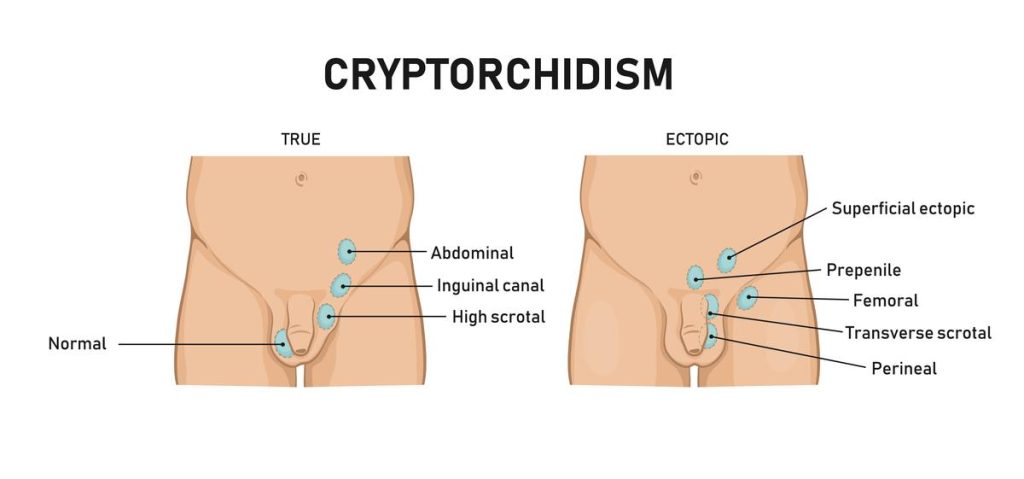Undescended Testicles (Cryptorchidism)

During the development of a male baby in the uterus, the testicles form in the abdomen. It is common for the testicles to descend from the abdomen into the scrotum before birth. The scrotum, located behind the penis, is a skin sac that holds the testicles.

The condition known as cryptorchidism occurs when testicles do not descend into the scrotum during or shortly after birth.
What are the causes of an undescended testis?
The exact reasons for undescended testis are not fully understood. Several factors have been suggested as potential causes.
- Genetic causes
- Issues with maternal health stem from hormonal imbalances.
- Environmental factors, such as hormonal influences, can be the underlying cause of undescended testicles.
- Physical factors and issues related to nerve functionality
Problems associated with undescended testicles
There is a connection between undescended testicles and various health complications and disorders, such as:
- A boy’s confidence and self-esteem can be affected negatively by abnormal testicles, leading to a poor self-image.
- A boy who has undescended testicles has a higher chance of developing an inguinal hernia, which is an abnormal bulge in the groin region.
- Injuries are more likely to occur with an undescended testicle.
- Infertility occurs when testicles, which need a slightly cooler temperature for sperm production, do not descend into the scrotum from a young age. Even if corrective surgery is done, men who had undescended testicles in their youth still have higher chances of infertility.
- Having two testes that have not descended increases the likelihood of experiencing a shortage of testosterone, which is a type of androgen.
- The chance of developing testicular cancer is significantly higher for males with undescended testicles, ranging from five to 10 times greater compared to the average male population. This increased risk may persist even after corrective surgery, especially if the surgery is postponed until later in childhood. Testicular cancer typically arises in individuals between the ages of 25 and 40.

How are undescended testicles treated?
If your child’s testicles have not descended into the scrotum by the age of six months, it is advisable to discuss treatment options with your healthcare provider. A pediatric urologist is a specialist who deals with undescended testicles.
There are various treatment options available for undescended testicles.
- In some instances, particularly when the testicles are located close to the scrotum, hormonal treatment may be suggested by your healthcare professional. This involves administering a series of hCG injections to the child, which encourages the descent of the testicles into the scrotum.
- Surgery is the prevailing and successful method for treating undescended testicles. The operation, known as orchiopexy, involves relocating the testicles to the scrotum. It is generally recommended to have the surgery performed on your child when they are between six months and one year old.
Orchidopexy
If the testicle is palpable in the groin area, a straightforward orchidopexy surgery can typically be done.
To begin, it is necessary to create an incision in the groin area in order to locate the testicle that has not descended.
Afterwards, the testicle is brought down and relocated to the scrotum by making another cut.
Sometimes, when the testicle is believed to be situated higher up in the abdomen, a procedure called laparoscopy is performed in order to find it and then move it to its correct position.
This procedure requires inserting a laparoscope, which is a small tube with a light source and a camera, through a small cut in your child’s belly.
In some cases, a testicle that is located within the abdomen may be surgically moved down to the scrotum in one procedure, while in other instances, it may require two separate stages to relocate it.
If the testicle cannot be felt in the scrotum, there is a slight chance that there is no testicle present on that side.
The reason for this could be that it didn’t develop correctly or it became twisted and deteriorated at an early stage of life. This would be verified through the laparoscopy procedure.
After the procedure is finished, the incisions are typically sealed with dissolvable stitches that do not require removal.
Orchidopexies and laparoscopies are conducted while your child is under general anesthesia, ensuring they are unconscious throughout the procedure and do not experience any pain.
Typically, the procedure lasts approximately one hour and is commonly done on an outpatient basis. This implies that your child will be able to go back home the same day.

How long does it take to recover after an orchiopexy?
After having an orchiopexy, many children experience fatigue and may find themselves sleeping more for the next two to three days. This increased sleep helps their bodies to heal and recover quicker.
Most children who are at least 12 months old can return to their regular routines within two to three days after undergoing an orchiopexy. However, they should refrain from engaging in any activities that put pressure on their abdomen or groin area. This may involve actions such as tumbling, jumping, sprinting, lying on their stomach, and using toys that require straddling, like a rocking horse, see-saw, swing, or tricycle.
In order to avoid infection, it is important to maintain cleanliness in the areas that are affected. Prior to dealing with your child’s bandages and incision areas, remember to wash your hands using soap and water.
It is acceptable to shower or sponge bathe your child, but it is advisable to refrain from washing them in a bathtub for approximately one week.
It is crucial to keep in mind that every child’s body is different, so the time it takes for them to recover may differ. It’s important to follow the guidance of your healthcare provider regarding how to handle your child’s pain and discomfort.
When should I call my healthcare provider?
If your child encounters any of the following situations, make sure to contact your healthcare provider:
- The presence of bleeding or symptoms of infection at the location of a surgical cut.
- Severe pain in their groin.
- Side effects of hormonal treatment.
Treatment in Türkiye:
The medical staff of surgical teams, doctors and consultants in Rehab Türk can provide the best treatment options and free consultations – by striving to keep abreast of the latest medical technologies and methods.
